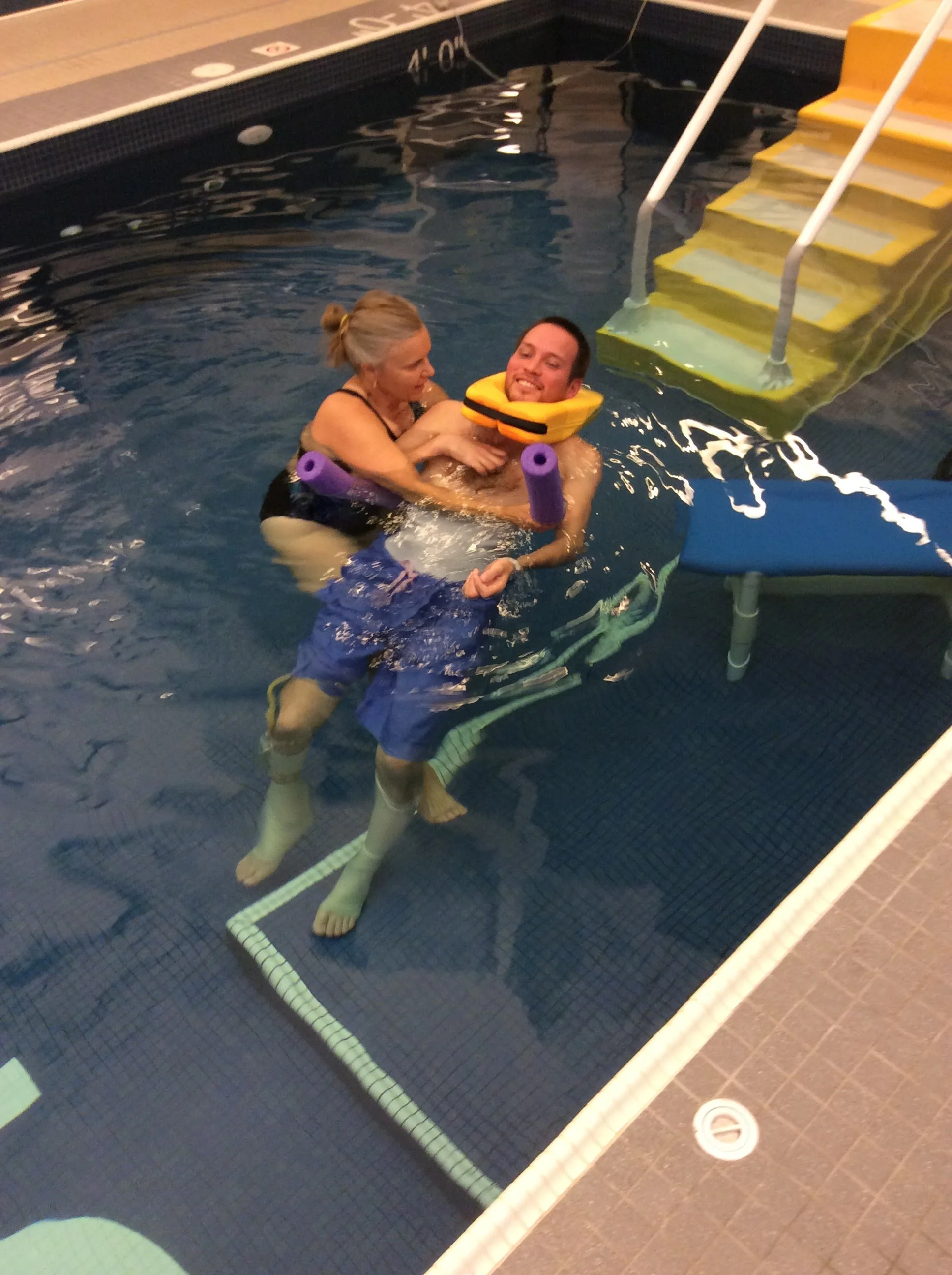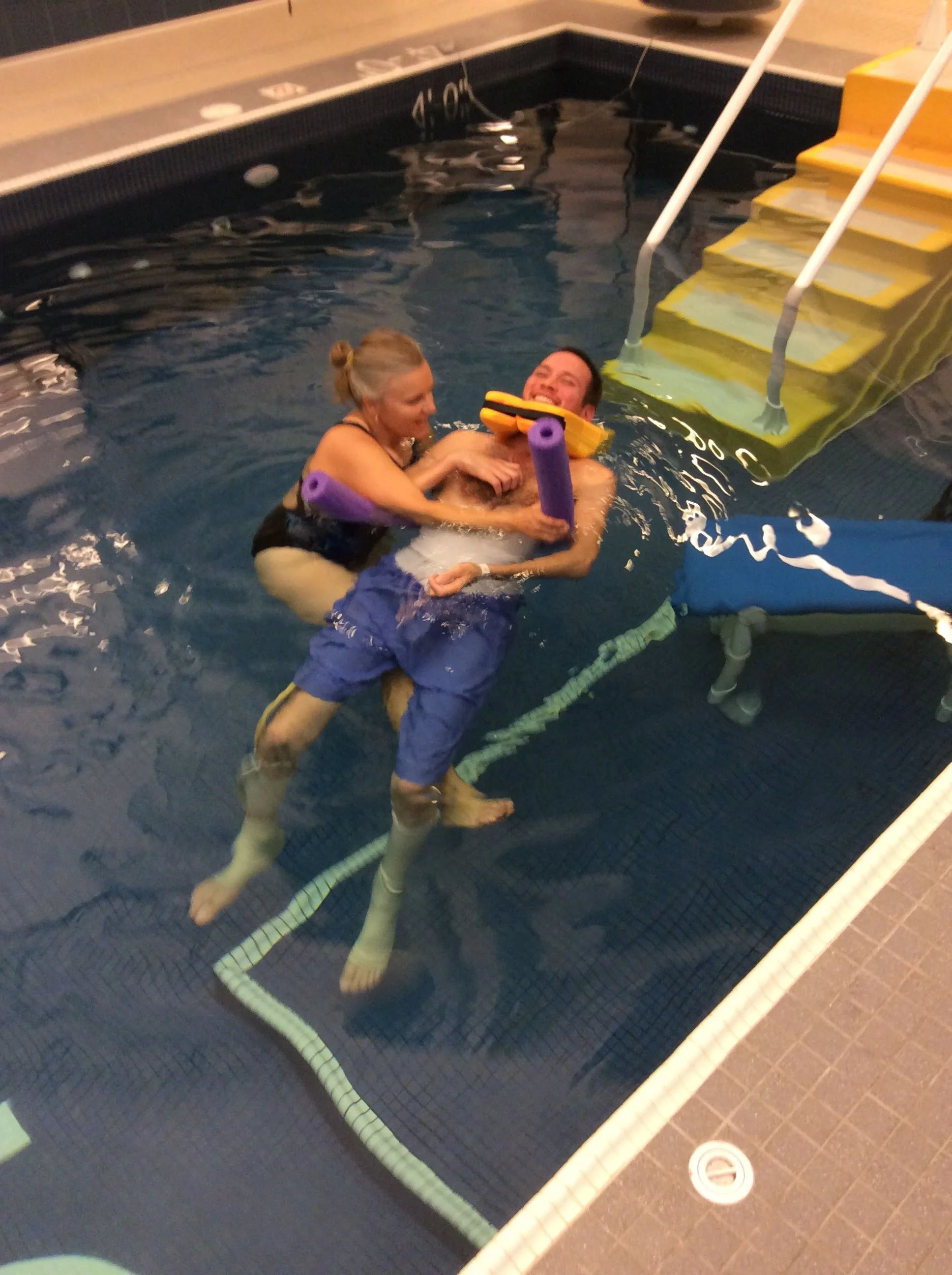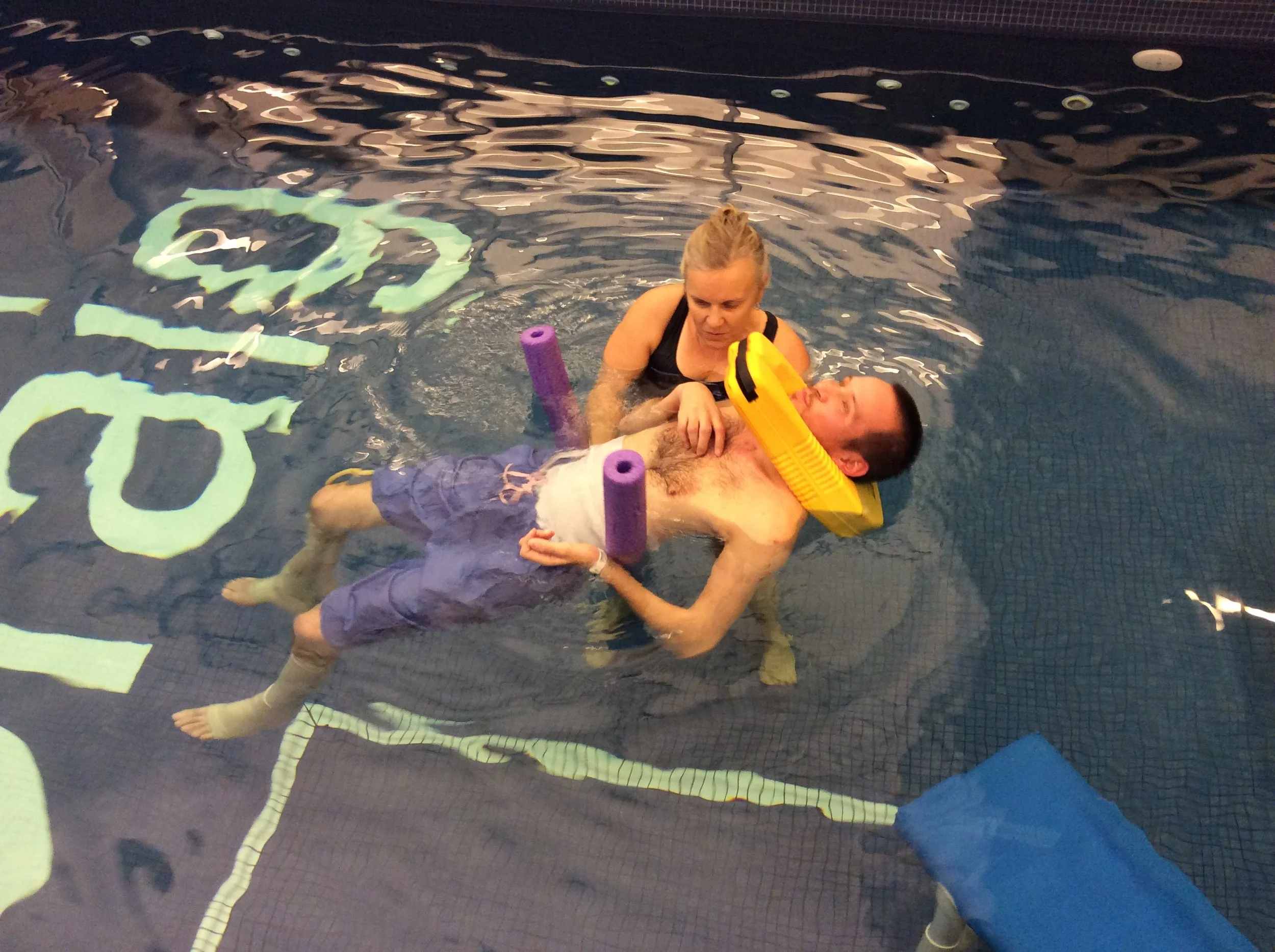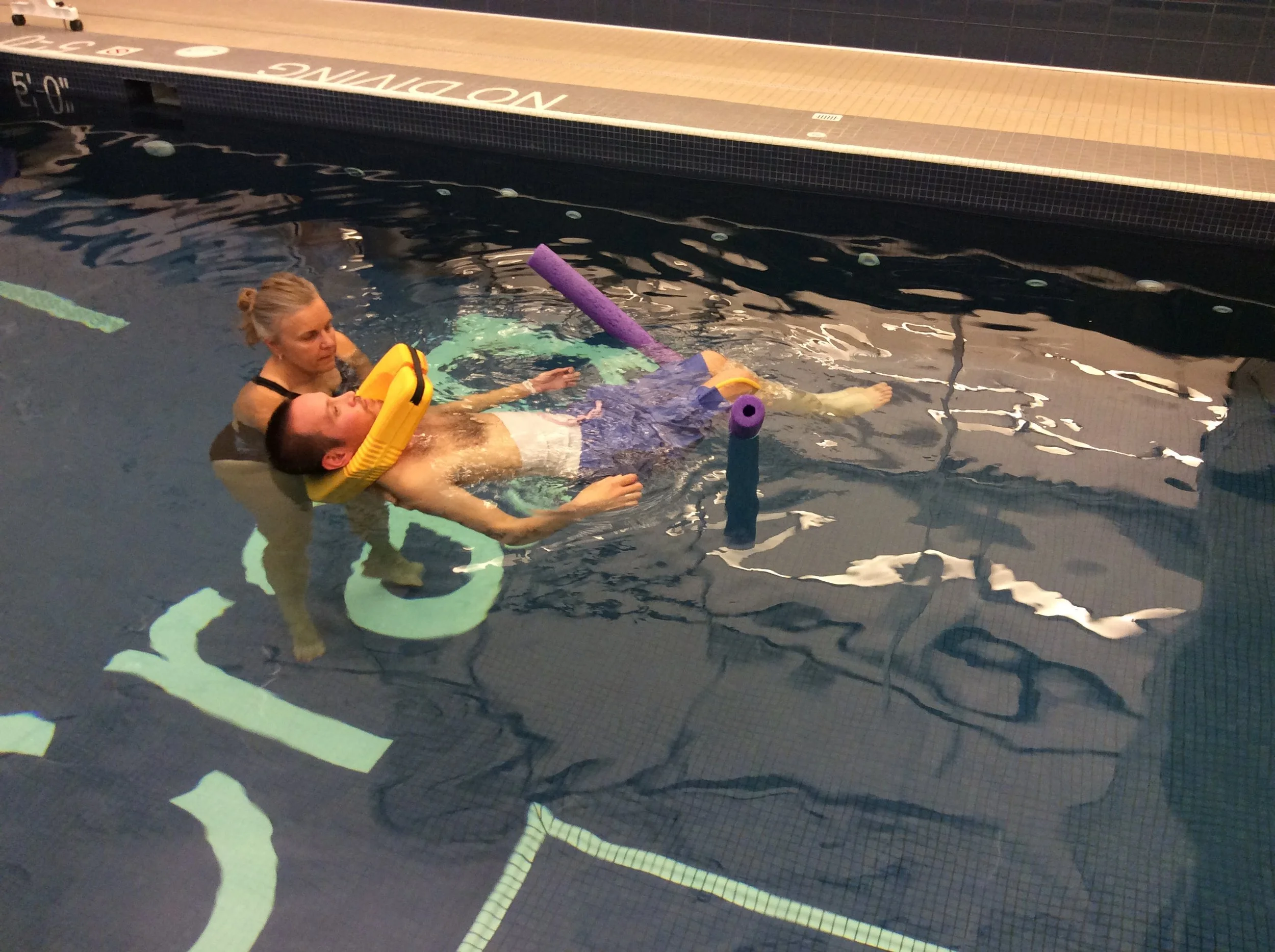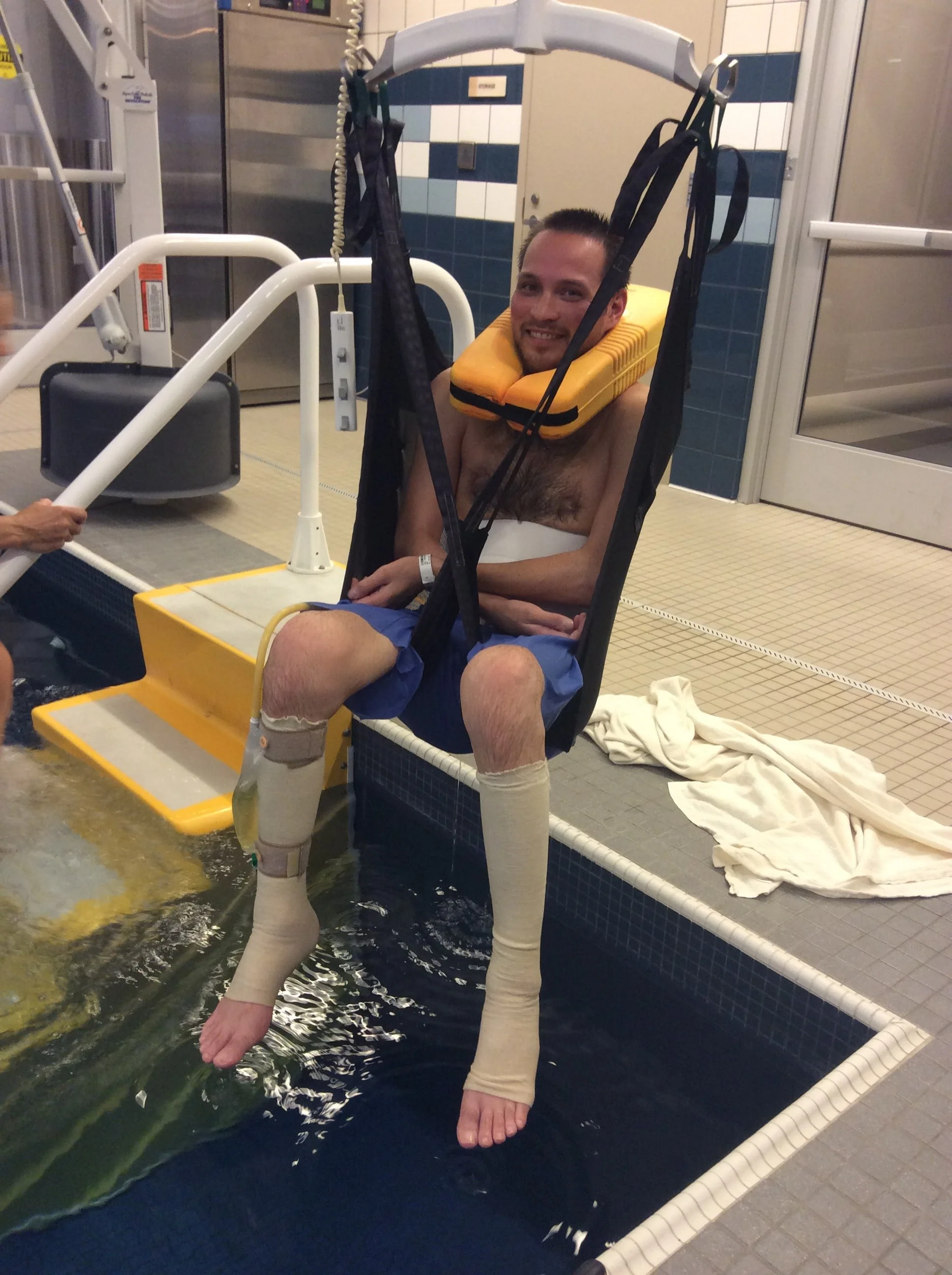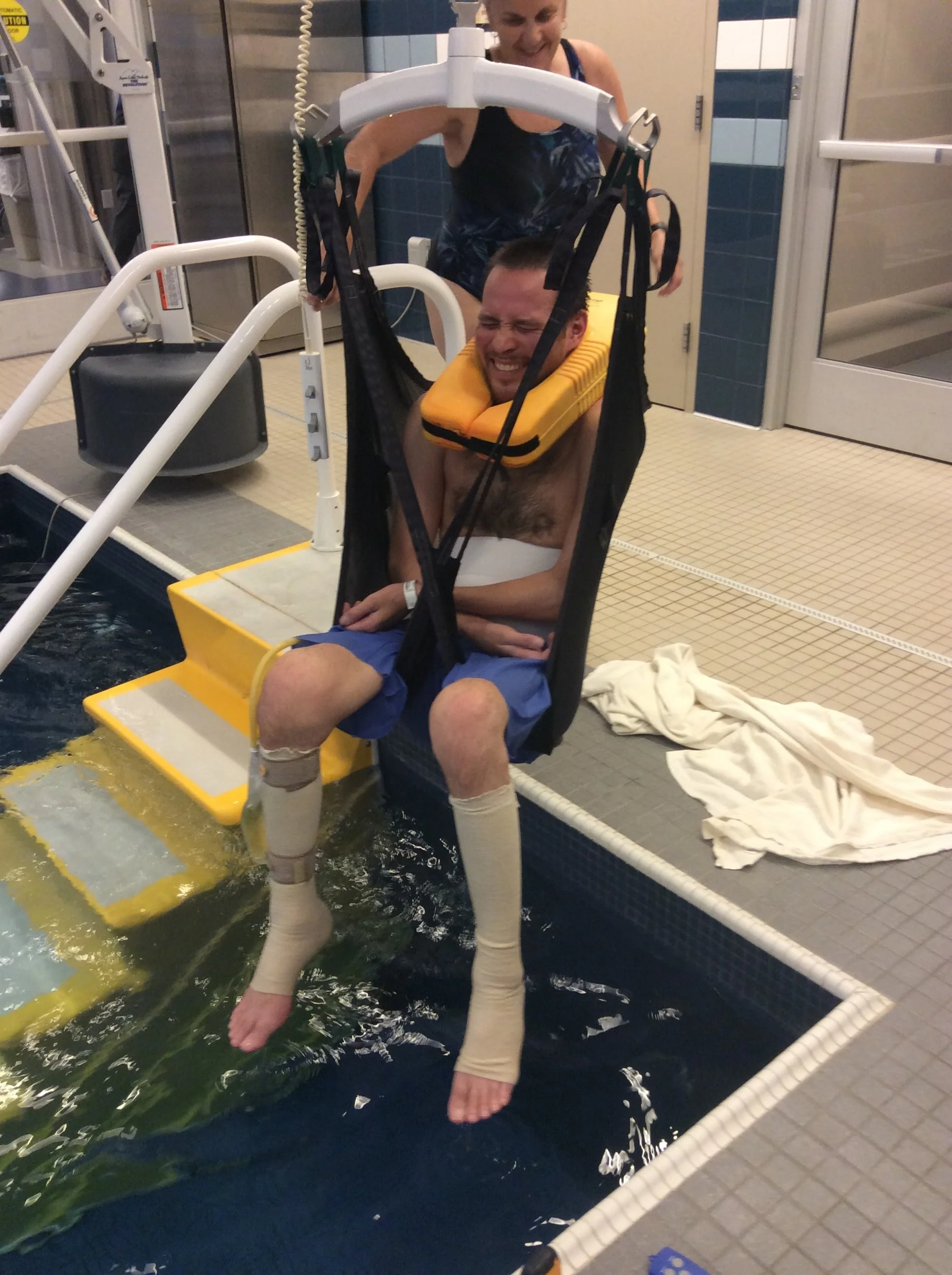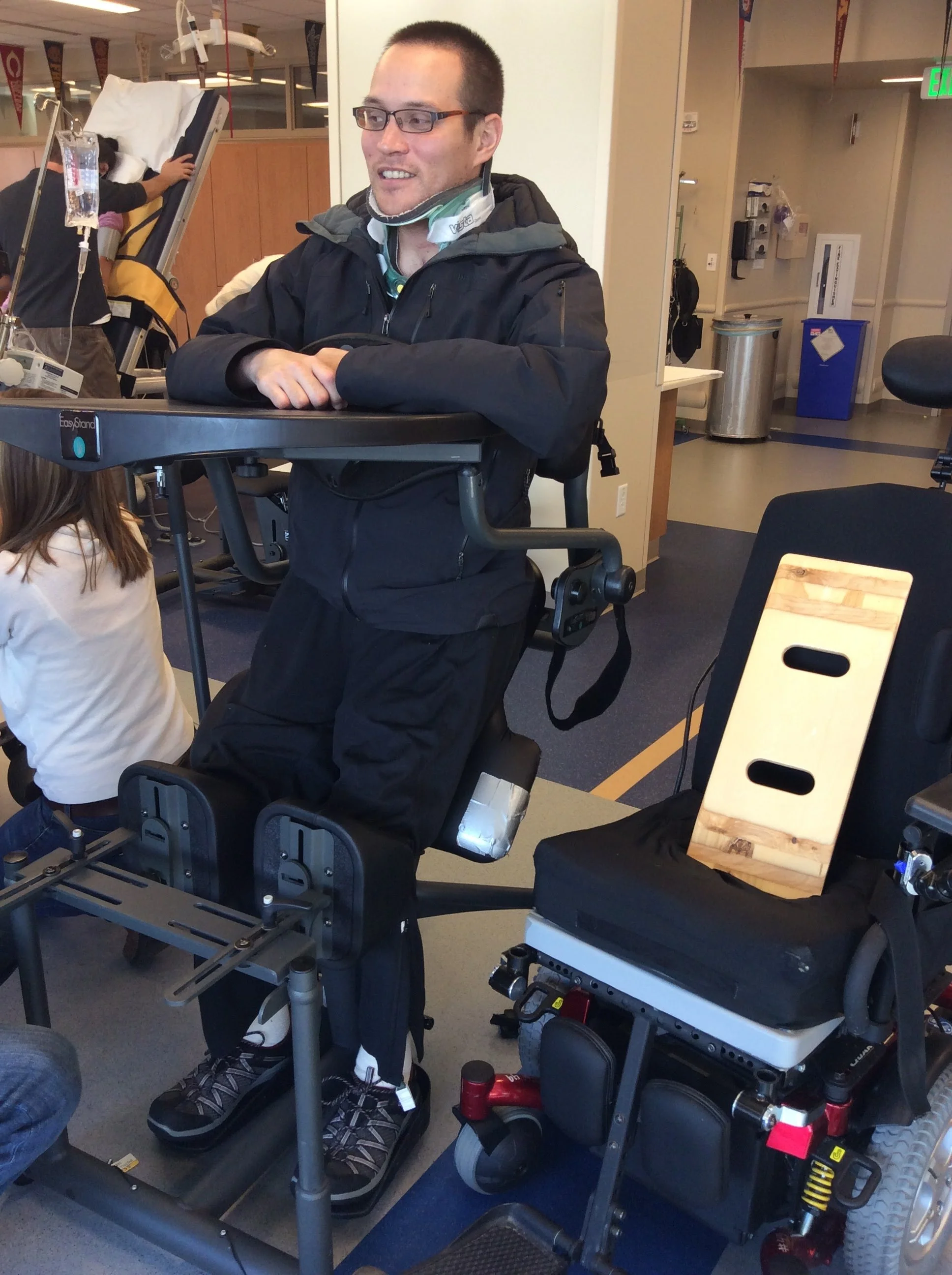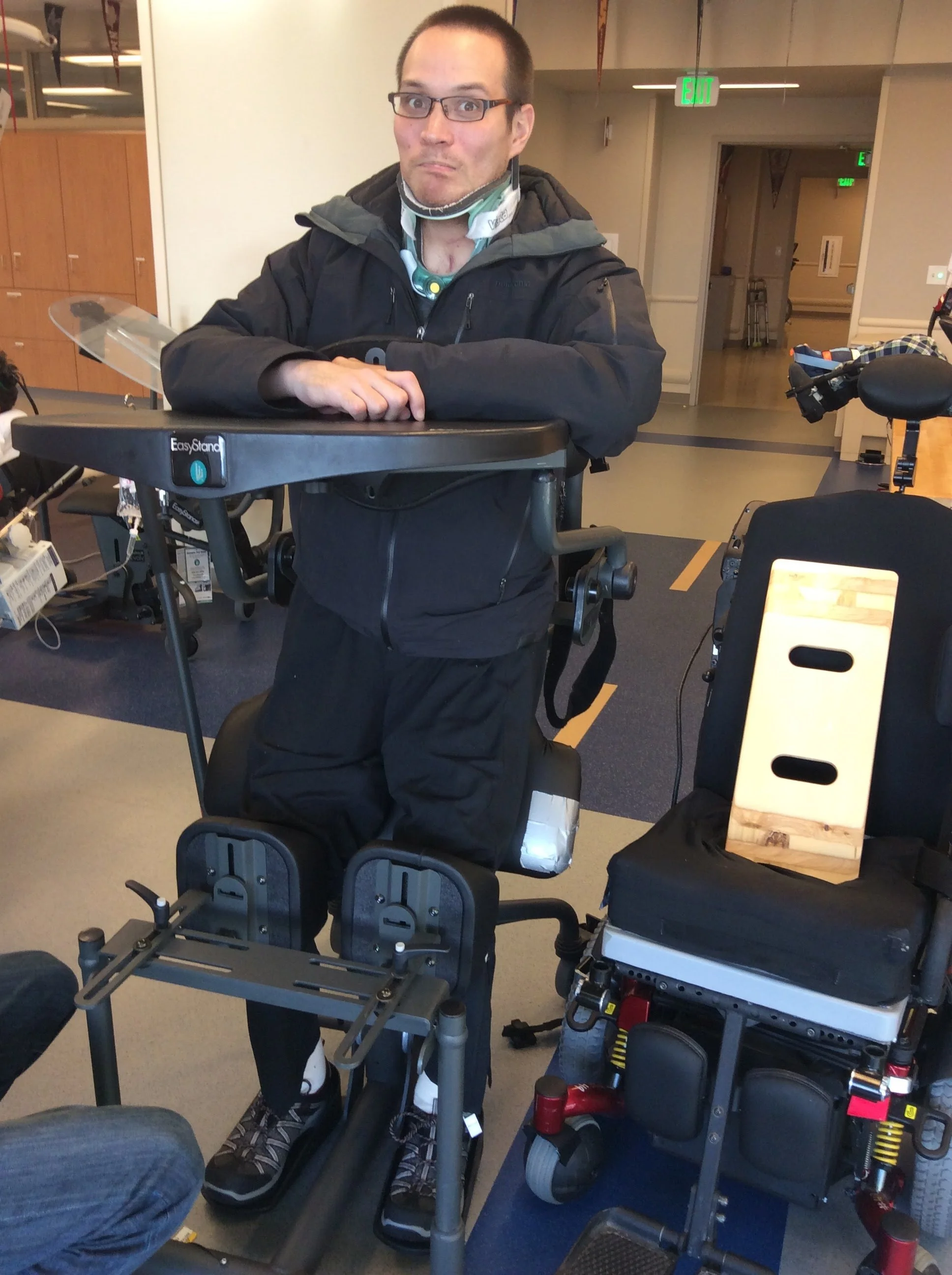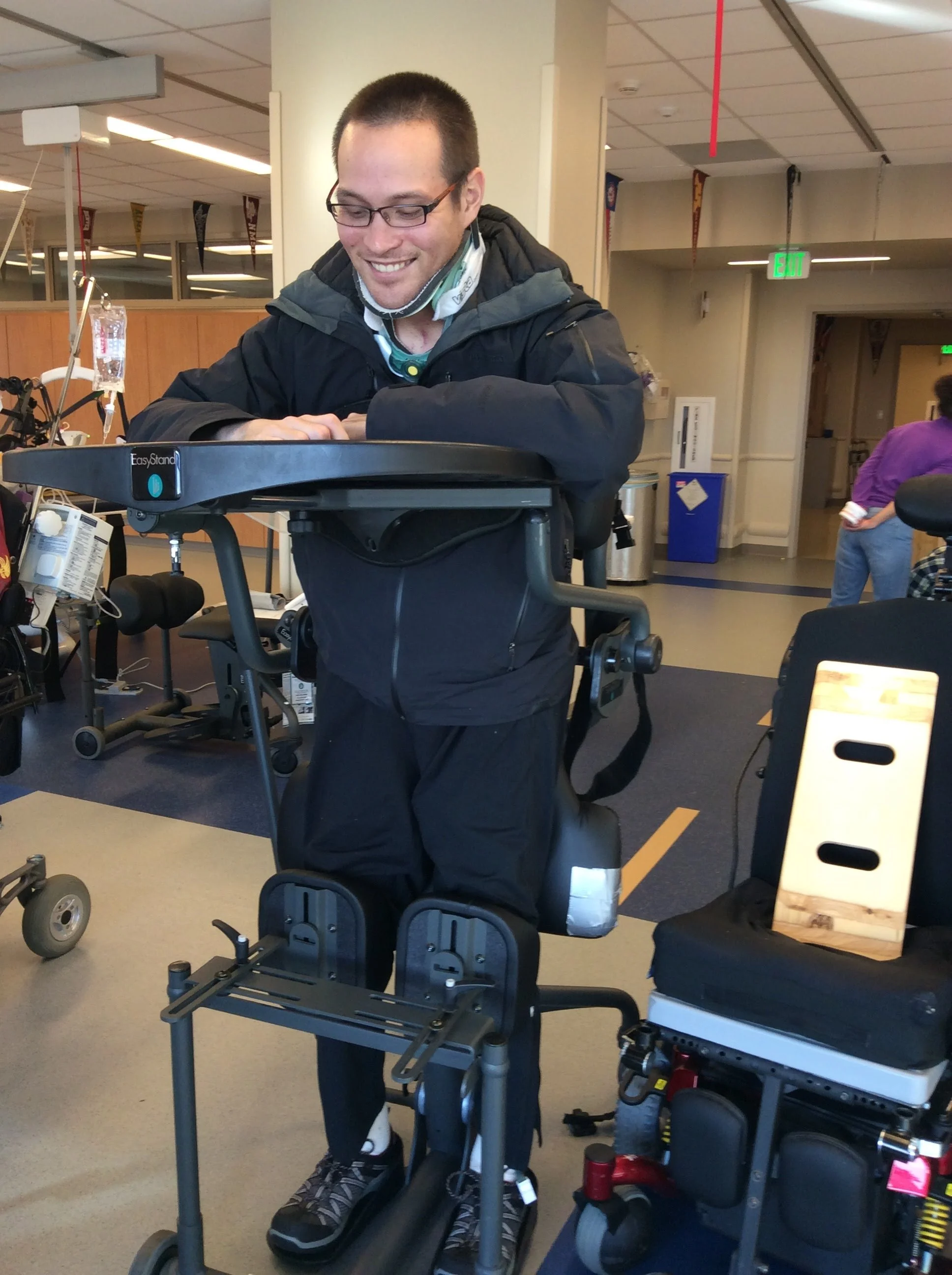Chapter 12 – Typical therapy sessions
After a few weeks at Craig Hospital, the “discount waterboarding” from the ICU had become disturbingly commonplace. I no longer had a sense of dread before it happened and just thought of it as the easiest way to clear my lungs. It’s not like it was pleasant, it was just effective and I had managed to learn to take slow deliberate breaths while they were suctioning things out. Being able to tolerate the suctioning meant that they were typically able to do a more thorough job, meaning I probably had to have my lungs suctioned fewer times. At some point, it was time for my sister and dad to learn to do it. I think my dad had done it before as a doctor in Japan, which was quite a while ago, but I didn’t have any worry about his abilities. My sister is also a doctor but had never performed that procedure before and her apprehension at doing it matched my own; it’s not that she was a bad doctor, just that her doctorate in Japanese history just wasn’t likely to be super useful at this particular time.
In any case, in order to be cleared to do that procedure, they would have to take a specific class at the hospital; my dad, my sister, and Tyler went to get certified and cleared. In that class, they learned how to operate with one hand designated as “dirty,” with the other hand as “clean.” This is because they were going to be snaking a catheter into my lungs through the tracheostomy and the last thing you want is to make things worse by using the catheter as a germ and bacteria delivery system. The “dirty” hand could touch the packaging, tray, the trach, etc., while the clean hand operated the catheter. Each time, a catheter would get attached to the vacuum line on the wall through the catch can, removed from the packaging, and dipped in sterile water before being inserted into my trach. The catheter would be pushed in until they met resistance, hopefully at the bottom of my lungs, and they would cover a valve with their thumb which activates the vacuum suctioning.
Over time, it was happening so regularly that I started to realize that, as unpleasant as the experience was, it was not only tolerable, but if I relaxed enough, I was able to breathe. Mmmm, ok, “breathe” might be an overstatement because it definitely wasn’t sustainable but it was good enough to provide a bit more time for the person doing the procedure to really do a thorough job. That meant I had to have them do it slightly less often, which is great for everyone. As I sit here and try to think of some frame of reference for the experience, the only thing that comes to mind is that it might feel similar to having someone tape your mouth and one nostril shut, making you cry uncontrollably, then asking you to breathe through that one snot filled nostril… while someone suctions air out of your lungs? Fun fact, most of what is coming out your nose when you cry is actually tears flowing in through the lacrimal ducts on the lower eyelid; you are basically just crying out your nose… slightly more interesting, slightly less gross.
In terms of actual therapies, the FES [functional electrical stimulation] bike therapy was probably the least taxing therapy in the regiment and always made me giggle. For the FES bikes, I would head down to the PEAK center, which was a gym designed specifically for spinal cord injury (SCI) and traumatic brain injury (TBI) patients and was filled with all sorts of specialized equipment, including some really high-tech machines. At the far end of the gym, facing a wall between two giant two story windows, were a set of what looked like stationary recumbent bicycles that someone had forgotten to install a place to sit. However, before you could pull up to the bikes, there was a bit of prep work that needed to be done; as with most things as a new quadriplegic, this meant prep work for others to do while you watch. To get ready for the bikes, the whole electrical stimulation part of Functional Electrical Stimulation, needed to be set up. For this, one or two therapists would stick credit card size gel pads with electrical leads to your calves, thighs, and butt after using a washcloth to clean the skin, making sure the pads stuck well. After the pads are attached, you roll up to the bike and position your chair in just the right place, because your feet get strapped to the pedals, it’s important to be centered and at the right distance or your legs start doing some funky things. Imagine clipping your feet to your bike pedals but then having your seat off to the side and too close to the pedals, oh but the pedals are pushing your legs. Once you are in position, your feet get strapped to the pedals, as mentioned, and those electrical leads get hooked up to their corresponding wires going into the FES bike.
The idea with the FES bike, if you were wondering, is to send electrical signals to specific muscle groups through those gel pads, in a timing pattern that corresponds to pedaling a bicycle. The bike controls the speed of the pedals and the corresponding electrical stimulation pattern, and shows an animation of a guy on a bike that corresponds to what your legs are doing, or, more accurately what is being done to your legs. The level of electrical stimulation was adjustable, to where you could have it barely tickle the muscles while the machine did all of the pedaling or you could ramp up the power and really make those muscles contract, which meant your legs were actually helping pedal. There was a constant read out on the screen telling you how much work it was doing and how much you are “doing.”
You are definitely supposed to think about trying to pedal, but it’s also difficult to not just space out, start checking your phone, or just start watching TV. It’s difficult, for me at least, to continuously concentrate on doing something that feels like it’s having no effect. How long could you sit and seriously concentrate on flapping your wings, just watching an animation of someone with wings? That’s kinda how it felt; I couldn’t feel my legs aside from a dull tingle and there was no change whether I was trying or not, making sustained effort really difficult. I tried to put in good effort most of the time and felt really guilty when I didn’t. I’m not a big fan of doing unproven things that “might help,” which is kinda how I view religion now that I think about it. That’s not to say that I didn’t do things that would fit that description, I definitely did, I just… had my own particular brand of irrationality?
If someone were to randomly visit during the FES bike therapy, they might think, “holy shit, you can move your legs!?” and it is certainly the most visually impressive therapy but actually represents the least amount of progress and effort, in my experience. It seems that it is often the least impressive looking things that represented the biggest marks of success during my stay in the hospital. I think it was the idea of trying really hard, mentally, to make something physical happen that was already happening that made me giggle. To be clear, aside from anything to do with moving your legs again, there is a variety of possible health benefits to FES therapy.
One of the massive benefits of being at one of the top rehab hospitals in the country is that they had all the newest toys to play with, including an entire suite of fancy machines from Switzerland. These included treadmills with exoskeleton legs to put patients through the motion of walking; treadmills with digital displays, force sensors, and image projection to help patients refine their gait; robotic arms that attach to the patient and allow for interactive games to be played with different amounts of assistance or resistance; and a harness which attaches to an overhead track and allows patients to walk with varying amounts of weight through their legs. In combination with the other brand’s machines, there were probably 15-20 different innovative therapies based around these larger pieces of equipment. I make this distinction because these larger machines are typically prohibitively expensive for hospitals and rehab facilities to use on a small number of patients. I didn’t use the vast majority of the machines but each new machine was just waiting to make the most of any function I might regain. I didn’t really have any sense of how much of a privilege it was to have access to all of these machines at the time. Everything could generally be replicated without the machines but it would all be far less efficient and less precise.
I wasted hours of therapy time staring at the machines and trying to dissect all of the engineering choices they had made; why did they need a cam gear there? So, what happens if that lever gets activated? Is there some external input which affects the way the system responds? Tell. Me. EVERYTHING!!! I’m sure my therapists were just sitting there thinking, “Dude, I just use the machines, I didn’t fucking design them. Chill.” Even though they were always nice, every now and then someone would indulge me and I’d get to ask all the questions that came to mind. The answers weren’t really the goal, per se, rather, they stood as indicators of my understanding of a concept. For example, with the functional electrical stimulation, the specific placement of the electrodes and the specific frequency, pulse width, and amplitude of the stimulation, all required a solid understanding of electricity and magnetism, as well as anatomy… or more likely, they pointed to gaps in my understanding of how things work in the real word. In physics, we tend to idealize things to make calculations simpler; the standard adage is that if you ask a physicist what shape a cow is, they will quickly tell you they are approximately spherical.
The machine I ended up using the most was one that attached an exoskeleton arm to mine, which allowed for different amounts of assistance or resistance to different motions. The machine incorporates the 3D position of the arm into computer games displayed on a monitor in front of you, and helps guide you through different functional motions and strengthen your arm in a targeted but progressive manner. The games weren’t exactly AAA titles, and kinda looked like a game designer's first crack at creating a game. There was a bootleg version of Mario Kart, where you pushed your arm forward to accelerate, pull back to break, and move left and right to steer. Sounds easy enough, but holding your arm in the air feels like holding a bucket of water at the end of your outstretched arm; the burn and exhaustion makes fine motor control much more difficult. Each game targeted a different functional movement and combined, they increased strength, stability, and range of motion. Most of the time I was just imagining using it to control a robot arm, something akin to the da Vinci Surgical System.
Some of the machines in the PEAK Center:
Ekso – A mobile exoskeleton that helps patients who have complete paralysis of their legs and trunk, stand and walk over the ground.
ZeroG – Provides an overhead support system to give patients a variable amount of support depending on their level of injury or gait impairment, which helps maximize recovery by allowing for a wide range of supported positions. Very close to being a marionette.
Indego Exoskeleton – A powered “lower limb orthosis” that helps people with impaired mobility, stand and walk. Basically, robot legs.
Lokomat – A robotic locomotor training system that uses a bodyweight-supported harness system over a treadmill to help people with little leg movement achieve a walking motion.
WAVE Whole-body Advanced Vibration Exercise – Increases muscle activation by stimulating the tonic vibratory reflex to improve strength and function of the limbs and trunk.
RT600 FES Elliptical Trainer – Stimulates up to 10 muscle groups and helps decrease muscle atrophy while increasing muscle activity in the lower extremities.
HydroWorx 12000 pool – An underwater treadmill, where the floor started at ground level, allowing a wheelchair to roll in. The floor would then lower, submerging the whole space in water.
I think the biggest non-medical sense of relief I had was being in the pool, though I only used the fairly standard small pool (maybe 10 m?), not the Rolls-Royce of pools, the HydroWorx 1200. I had several sessions tentatively scheduled for the regular pool and was looking forward to them. The thing is, one requirement to get into the pool is that you haven’t shit yourself in the week prior to getting in… fair enough. Let’s just say that those tentative sessions kept getting pushed back. Finally, when I cleared that basic protocol, I was ready to go swimming. I didn’t have my swim trunks with me in the hospital so my nurse or CNA grabbed a pair of scrubs and just cut them into shorts. Despite going to the pool, I was still wearing long compression socks and a binder, which is just a wide elastic band around your waist, think ultra-diet corset, it was quite the look.
After transferring into bed so they could change my clothes, I was hoisted back into my chair and sent down to the pool. When I got there, they had me position my chair just outside of the pool next to a special lift. Once they had the sling underneath me, I was craned up into the air, swung over the pool, and slowly lowered into the water. To make sure I didn’t just sink to the bottom and drown, they put what was basically just a foam square with a hole for my neck on me and threaded a pool noodle behind my back and up through my arms. With a bit of support from who teaches scuba diving, I floated around on my back and enjoyed my new found range of motion; it had been a long time since I was able to voluntarily reach above my shoulder level, much less straight overhead. At one point, she strapped paddles to my hands which let me drift around the pool with a bit more intention. I guess it was the first time since my accident that I was able to easily move myself around, no wheelchair, no therapist, and no painful straining. Add in the fact that the warm water did wonders to relax all of the muscles in my neck and shoulders that had essentially become permanently tense, it was fantastic. Aside from constantly being worried about shitting myself in the pool, the whole experience was really really nice. In the end, my chair was covered in towels, I was craned back in, cocooned in more warm towels, and sent blissfully driving back to my room; I was so relaxed I almost felt drunk.
I never got to use the HydroWorx pool but I feel it’s important to stress how cool this thing is. The floor of the pool is fully adjustable, meaning that you don’t need a lift to get in, you just walk onto the floor and it lowers to the required depth. Not only that, but the whole floor acts as a big variable speed treadmill for walking therapies. To help with that, there are a number of underwater cameras that let therapists closely monitor a patient’s gait from multiple angles. Aaaaand, the jets in the pool not only make it turn to an infinity pool for swimming therapy but also provide deep tissue massage for patients… I mean, come on, that’s pretty cool, right!? Plus, my friend Erin is friends with the daughter of one of the guys who designed it! It’s a small world.
The standing frame for quadriplegics is like G force training for fighter pilots. The idea of the frame is to help SCI patients get into a standing position, which puts weight through your legs to help prevent a loss in bone density and also helps set a higher baseline blood pressure. I basically have the issues experienced by astronauts and fighter pilots, just without the benefit of going to space or flying planes. You start in a seated position with a padded block holding your knees in place so they don’t just buckle or bow as you are stood up. To the side of the chair is a long lever and each time you pull on it, the back of the seat begins to raise and move forward in small increments, slowly bringing you to a standing position where a chest high table is waiting to support you. However, the first few times I tried to go up, I didn’t make it past the first few degrees; if 0° is sitting and 90° is standing, I probably made it to 15° before I started blacking out. Thankfully if you push the lever, it quickly lets you back down into a sitting position. We would go up slowly, pausing every few degrees to allow me to renormalize before continuing. Even using this slow and steady procedure I couldn’t make it past 45° before the silence would grow deafening and the world would be quickly swallowed by darkness. I tried eating before, not eating before, taking blood pressure medication, and even drinking Mountain Dew; I’m not going to lie, that stuff is pretty repulsive but apparently has a lot of caffeine which can temporarily spike your blood pressure. According to the Mayo Clinic, this happens because… who the fuck knows? Does it block hormones that keep arteries widened? Does it cause the adrenal gland to spike adrenaline production? Unfortunately, unclear…
Fighting to stay conscious
I remember the first time I was able to get into a fully standing position. I wish I had some explanation for why it worked but all I remember is constantly being surprised that I wasn’t blacking out and we just kept going up. For me, it helped to not wear a binder or corset but to put one on just for the standing frame. Eventually, I just skipped the corset all together and just went from sitting to standing relatively quickly but having the chest pad set up to press into my abdomen relatively firmly, taking the place of a corset. In any case, that was the first time I had been fully upright, at eye level, with people. In my chair I am around 4’ 7” but in the standing frame I stood tall at around 6’2” and there is a distinct difference in the way people interact with you at those different heights. I remember one of my therapists remarking that I was taller than they thought, despite having worked with me for a few weeks already. Beyond just the physical benefits of using the standing frame, I feel like it also provides a nice emotional or morale boost.
Moving from vertical to horizontal orientation [standing to sleeping], back in the room, you hear the door creep open, or maybe it’s the light from the hallway that wakes you up. “Good morning!” STAB STAB STAB, aww what the fuck… ok, “stab” might be a bit of an aggressive description, but when the first solid connection to reality you have after being woken up at 5 am is a rubber band around your arm, a cool sensation in the crease of the elbow, followed quickly by a needle poking you in the arm for a blood draw, it feels aggressive. Hopefully they are able to find the vein and get it on the first try. Though, given that they are trying to do everything in relative darkness with an impatient in-patient with low BP, it’s impressive they get it at all. There was one older phlebotomist who I remember being truly impressive, he would slip in without making a scene, he had a way of waking you up without it being jarring and was skilled enough to not only get it on the first try but to the point where I was able to fall back asleep before he was done on more than one occasion; he was a magician.
On the other side of things, one morning it was a younger guy who was coming in for the blood draw, and things did not go quite as smoothly. Not only did he miss and have to retry 5+ times, every time he tried, he would fish the needle around trying to find a vein. When that didn’t work, he switched to the other arm to see if he would have any more luck… nope, he didn’t. I felt bad, with each miss the anxiety in his voice was climbing as he constantly apologized. It’s really difficult to not show your frustration with the fact that each attempt was making it less and less likely that you will be able to go back to sleep, no matter how many times you tell them, “It’s fine.” It’s similar to when somebody wakes you up to ask you a question; if they wake you up and quietly ask a single question, it seems like an unremarkable event, but as the questions become louder and more numerous, the desire to throw things at that person increases exponentially. In this analogy, each successive attempt is like a new question and how long they fish around in your arm trying to find the vein represents the volume of each question.
I’m sure I asked at some point and received a reasonable answer, but to this day I do not remember why they thought that waking people up for blood draws was good for the mental health of anyone involved. I don’t consider myself to be a great person, or even a good person for that matter, but I’m well aware that there are far bigger ass holes out there in the world, and I can’t imagine the physical or verbal abuse healthcare workers must endure on a daily basis. So, to all phlebotomists out there, including the guy who stabbed me like a million times that morning, thank you for putting up with us.
Speaking of unpleasant experiences… I’m not sure if it is because the muscles that oppose the movement aren’t responding or if it’s just because they are the only muscles that work, but there were two motions that dominated the weeks and months after my accident. First, with every “shiver” or twitch, my bicep would pull my arm a little more into a chicken wing; my limp hand would end up just under my chin with my bicep pulled tight. At the same time, my shoulders start to climb up as my neck compresses downward, as if I was a turtle trying to pull my head back into my shell. It typically happened when I felt cold, which is the majority of the time when you are a quadriplegic. Your hypothalamus is responsible for both thermoregulation and fevers. However, if you break your spinal cord above the T6 level, signals to and from the hypothalamus are weakened or non-existent, impairing your ability to respond to environmental temperature cues.
This constant tension from the base of my skull down my neck and out to my shoulders was just relentless; with concerted effort and focus, I could relax a bit and keep from curling up, though I would always need someone’s help to pull my arms straight if I was in bed and couldn’t utilize gravity. Similar to decorticate posturing where you experience a loss of the extensor muscles in the arms; the biceps curl, the elbows tuck into the body, and the wrists bend down, except my wrists would go the opposite direction.
My doctor suggested we try lidocaine injections into the trigger points in my trapezius muscles. I had no reference point for that type of thing, it was the first I was even hearing what a trigger point is. Apparently, trigger points are taut bands of skeletal muscle located within larger muscle groups and can be sensitive when touched. The lidocaine is injected into the trigger points to get them to release and relax. The other therapy used at the hospital involves dry-needling, which uses very thin needles with no medication (“dry”) to stimulate the underlying trigger points and connective tissue, with the same end goal. However, studies have shown that the lidocaine therapy generally leaves patients less sore and sore for a shorter period of time, so that was option one. It’s pretty uncomfortable, as you might imagine someone digging needles into your shoulders might be. They are looking for a specific spot, which is indicated by a twitching response in the muscle. I found it pretty amusing until I realized that we were done but I was still twitching… and it did NOT feel pleasant. I mean, the muscles were already sore and tense, so adding in an intermittent intense pulse started out as painful and slowly progressed to be excruciating. In the hundreds of patients who have received the treatment at the hospital and the hundreds of patients I have read about in scientific studies, I seem to be unique in that reaction; the painful little snowflake (read as the title to a terrible children’s book.)
By the next day, when the pain and twitching hadn’t subsided, I was in tears. It was like having the hiccups, but instead of gulping air, you get mildly stabbed in the shoulders. It seemed clear that the pain wasn’t going away so my therapies for the day were canceled and I was given cyclobenzaprine, a muscle relaxer, to try and stop the spasms. I remember starting to slur my speech and lose what little control of my muscles I did have, and then I was out. I went in and out of sleep, waking for brief periods of time steeped in a post anesthetic like fog, telling my brain to just go back to sleep.
Over the next two days, we tried a number of different things to try to make it stop. They gave me heated blankets, massages, and drugs… They even created a makeshift heat pack by placing damp towels inside of a trash bag, sealing it, wrapping it in a dry towel, and microwaving it. Everyone was amazing and was doing everything possible to find me some sort of reprieve, but nothing seemed to have any lasting effect. I’m not sure how it came up but there was a woman there who did something similar to reiki “energy healing,” and despite studying physics and thinking it was total bullshit, I decided to give it a try; anything to get rid of the pain. I can’t really provide you with much information on how it works, as that seems to be ill-defined. In any case, maybe it was the relaxing atmosphere, maybe it was just coming to an end, or maybe whatever she was doing was working, but by the time she was done, my shoulders had relaxed a bit, and most importantly, the painful twitching had finally subsided. I can’t really claim that I am any less skeptical about energy healing, a sample size of one is not very scientific, but I would definitely give it a shot if I found myself in a similar situation again.
Feeling like a human again, it was time to make a bit more effort to look like one. Looking back at pictures from Craig Hospital, it appears as if I had just cut my hair and shaved shortly before the accident. For me, this meant that I had taken a set of clippers with a #2 guard and buzzed my whole head, a tradition I had maintained for at least a decade. The recency of the haircut meant that neither was an issue while I was in the ICU; however, now that I had spent some time at Craig hospital, it was starting to become an issue. For those of you without facial hair, there comes a point in growing it out where it becomes unreasonably itchy, it feels like your face and neck have suddenly become host to a colony of fleas. This feeling was exacerbated by the fact that I was stuck in a neck brace and made particularly cruel by that whole, “not being able to even reach my face to scratch it” thing. I remember the countless times where I had people scratching me under the chin like I had been a very good boy, like I was an elated old dog. The problem is, how do you cut someone’s hair or shave their beard when they are wearing a neck brace that is covering considerable portions of what needs to be cut?
Removing the neck brace felt a bit like if you had just glued something back together and weren’t sure if it would hold together but you needed to let go and see. Except, the thing you are gluing together is your neck and if it falls apart, you can make yourself more paralyzed. It all just feels so precarious, the loud clicking noises and the shooting pains just add to the anxiety.
When the problem had become too much to be allowed to continue, the plan was to go for a shave and leave the hair for now, because priorities. For the shave, my neck brace would be removed and someone would hold my head in place as someone else would shave my face using some electric clippers; for the first shave, these duties were taken on by my sister, my friend Autumn, and my nurse. I don’t know if it was because I couldn’t feel much else or if I had some heightened sensitivity to pain but I definitely jumped a number of times when it felt like the clippers were pulling the hair out of my face rather than cutting it. I don’t remember that ever being a problem with those clippers before the accident but I definitely remember the consistently it would happen when in the hands of someone else.
It’s one of those situations you find yourself in quite frequently as a quadriplegic who was used to doing things for themselves [cooking, cleaning, fixing things, making things, etc.]; you have to ask someone else to do something for you and you have to live with the fact that maybe they are not as anal retentive about the details, maybe they don’t share my same neurosis for things being oriented perpendicular or parallel relative to each other, maybe I’m just not able to perfectly articulate exactly what I want, articulating your exact desires is both difficult and tedious. Or maybe they don’t have the physical attributes required for the task, etc. The list is endless and is endlessly frustrating, but that frustration is the motivation for my moves for independence. There are only so many times you can stand someone, trying their honest best, putting your underwear on very clearly sideways. The rest of the shave was a mix of gratitude and contempt. Honestly, it probably would have pulled hair out regardless of who was doing it but it’s much easier to accept when you are doing it to yourself vs someone else doing it to you.
The relative of another patient on the floor was a hairdresser, I think, and they came by and cut my hair for free and the experience was entirely pleasant as far as I can remember. Well, minus the typical rush of anxiety or panic that came with taking the collar off for any reason. Again, to whoever you are, thank you.
Through all of the different therapies, I was still working with the full neck brace and full-sized trach, which was usually plugged by the red cap. Once they put the red cap on the trach, the next step is to incrementally decrease the size until finally removing it. This allows the hole to gradually close before putting a bandage over it and letting it fully heal. The idea that I wouldn’t need stitches or really anything more than a fancy band-aid to close the gaping hole in my throat was wild to me. However, before that, it would need to be removed and replaced 3 or 4 times. These changes were generally very quick and painless. For each change, someone would hold the trach in place as the gauze going around the back of your neck to hold it in place is cut. Then the cuff blocking the airway outside the trach is deflated and the trach is removed as you exhale. The area around the stoma is cleaned before the new smaller trach is lubricated and inserted as you inhale.
Unfortunately for me, the first time they went to change it, it had been in for a significant amount of time, meaning that it had become slightly stuck. When they deflated the balloon and tried to slide it out, it caught and had to be worked out. I don’t remember it being particularly painful but I distinctly remember the sharp anxiety on every subsequent attempt. It probably related to both the fact that it was hardware in my throat and all of my previous adventures in not being able to breathe; the stakes felt high. I guess the anxiety, or the irrationality of the anxiety, is similar to adults who are terrified of needles and injections. The pain is negligible but you have already attached a feeling of fear to the action. It was to the point where I would consistently try to push it off as long as possible, which ironically just prolonged the amount of time I had to have a hole in my throat. It was another example of my, “if it’s not absolutely destroyed or getting worse, don’t fix it” philosophy.
They would always get a little laugh out of my hesitance and would eventually convince me it would be fine, and it always was... save for the minor hiccup that first time.
Given that I couldn’t really see the trach, the first time the inner portion was removed to clean everything, I asked my sister to take pictures. It was really difficult to not be able to see what people were referring to when they were doing something with my neck brace, my neck, or my head. I was always trying to picture what they were talking about and to build a mental image but turning verbal descriptions into accurate mental images is not my strongest point, at least not with medical procedures and equipment. Though, sometimes it might be better to not see certain things, ya know, out of sight out of mind? I generally don’t get squeamish with medical procedures, which is why I enjoyed watching my own surgeries so much; however, the aftermath of my fistulotomy a few months after leaving Craig hospital, which I will discuss later, was something I wish I had listened to the doctor and just not looked at… it still makes me cringe a little [shark bite, ooh ha ha].
Much like with the downsizing of the trach, avoidance was my go-to strategy when it came time to remove it. You might be inclined to think I would have been chomping at the bit to get the piece of plastic out of my throat, given that I wasn’t even using the thing; however, when they remove it, there is no surgery, no stitches, no glue… just a fancy band-aid… to cover the hole in your throat. I wasn’t a huge fan of the whole removal process, but far less of a fan of the idea of just having a patch over the hole. Though, thinking back, I don’t really know what the functional difference really was in my mind, I would guess that it was simply the change to an unfamiliar situation. Everything in my life had just been blitzed in a food processor, and I was desperately grasping for some semblance of familiarity or permanence, just a bit of stability. The familiarity of having a tube of plastic stuck through my throat seemed more appealing than the novelty of, ya know, healing.
They indulged my little games to put it off for a while but eventually convinced me to just go for it. As far as I remember, it was as easy as taking a deep breath and then exhaling as they slid the trach out, painless. After cleaning everything, they placed a Tegaderm or Duoderm bandage over the front of my throat and that was that… kinda.
The opening typically heals surprisingly quickly, but the more pressure you apply, the more likely that you push air through the hole and increase the time to heal. So, every time you talk, strain, or do anything that increases air pressure in your lungs, you increase the likelihood of popping it open. Now, it’s not like it would just blow wide open, that flexible bandage was there to hold things together. But when you did push air through, the bandage would bubble up at that spot like the vocal sac on a male frog. Ribbit. It was conflicting, on one hand, it looked objectively hilarious, but on the other, I really wanted it to heal. On a few occasions, the bubble would push through an edge somewhere and would start leaking air, but a quick dressing change would set things right, and in a few weeks, everything closed up and healed.







